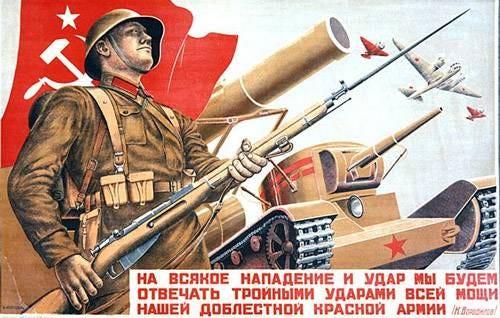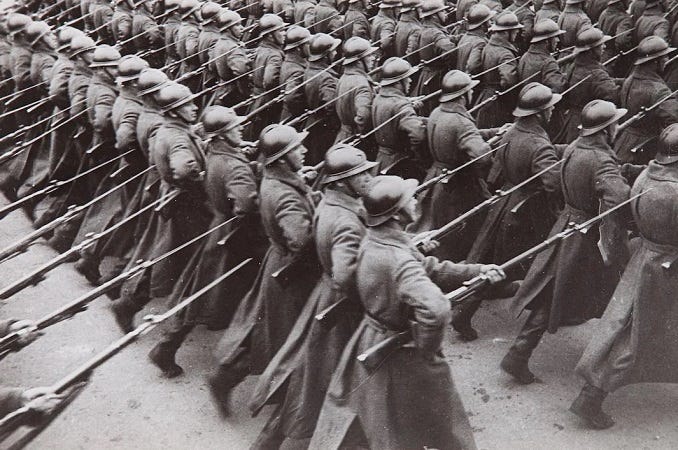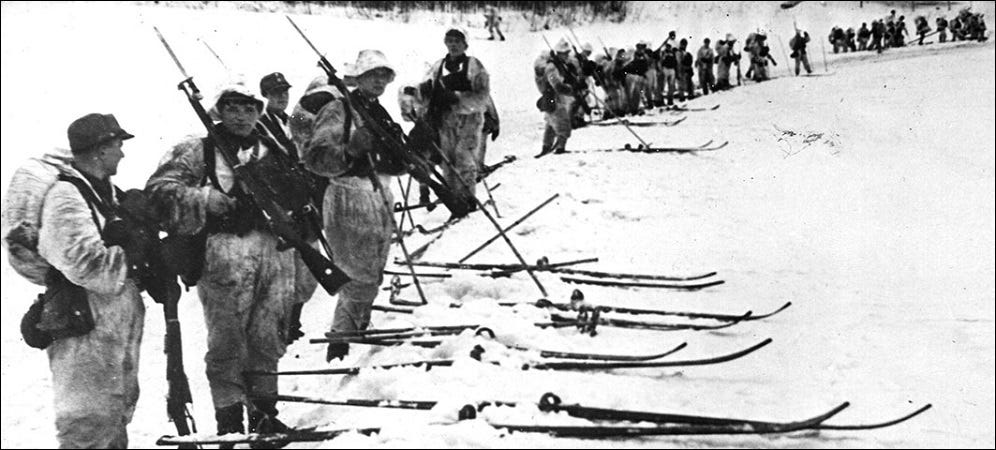My recent article, “Tannenberg Revisited,” has attracted a lot of attention—including considerable adverse comment from those in America and Europe who serve as apologists for V. Putin and his unprovoked aggression against Ukraine. No doubt some of this criticism, however misguided, is proffered in good faith by people who take the Russian regime’s propaganda at face value. Some of it, however, bespeaks either bad faith or a willful refusal to acknowledge reality. Here’s an example:
The worst assessment I have read so far since the beginning of Russia's "de-Nazification" of Ukraine. In fact, it was so distorted and inaccurate I was only able to get about a third of the way through it.
The Chechens, the Wagner Group and Russian hard core regulars are leaving corpses of Ukrainian proxies all over the eastern battlefields of Ukraine. Meanwhile, there are rail cars of Russian military equipment heading west. Kiev is going to wake up to the sound of Iskander-M rockets.
And here’s another:
The Atlanticists, the Neocons and the entire leftist ideology infecting the US military are collectively bat shit crazy at this point.
Even Dmitry Medvedev appears to be balking at the Atlanticists. Can only imagine now even more since the US was clearly behind blowing up the Nord Stream pipelines.
People who post stuff like this are simply refusing to acknowledge an irrefutable fact: that the Russian armed forces have proved themselves far less battleworthy than was generally assumed at the beginning of the Russo-Ukrainian War. It’s a fact most unwelcome to those who think they see in the present war an existential conflict between robust, conservative nationalism and soulless, money-grubbing globalism. The reverses experienced by Russia on Ukrainian battlefields give the lie to this formulation, a most unwelcome reality check for American national conservatives and assorted isolationists. And so, after every Russian setback, we hear the same thing from the Putin pep squad: Aha! Now Vlad has them right where he wants them! Just you wait and see!
In “Tannenberg Revisited,” I drew on one historical example to help explain what is happening now. But the Russians’ East Prussian debacle in August 1914 was not the only one I could have cited. Military disaster is, indeed, a theme in Russian history. The victory of the USSR in the 1941-45 Great Patriotic War obscures but cannot erase this record of incompetence leading to ignominious defeat. Many of the deficiencies that crippled the armies of Nicholas II and V. Putin also afflicted the Red Army at the beginning of World War Two, and they sprang from the same root: the fundamental nature of despotic regimes. It is to the credit of Stalin & Co. that they recognized and corrected these deficiencies in time to stave off defeat and then go on to triumph over Nazi Germany. But just as in 1914 and 2022, for the USSR the war began with a series of spectacular, nearly fatal defeats.
This was a surprise to many observers at the time. In the late 1930s the Red Army of Workers and Peasants—to give it its full official name—was widely regarded as the most powerful and forward-thinking army in the world. Years before the first German panzer division was organized, the Red Army set up a number of mechanized corps—in effect, armored divisions. It was also first in the field with parachute troops, counting more than a dozen airborne brigades in its order of battle by 1939. The artillery arm had always been the elite corps of the Russian army and by all appearances this tradition was being maintained in the Soviet era. All in all, there seemed to be a good deal of truth in the official propaganda line: that the Red Army was incomparably the most advanced and formidable fighting force in existence.
The Army’s basic unit was the rifle division, as its infantry divisions were titled. By comparison with the German Army’s standard infantry division, the 1939 rifle division’s size and strength were impressive. The German division had on average 16,000 men, the Soviet division 18,800. The Soviet division had a light tank battalion and an antiaircraft battalion; the German division had neither. The Soviet division’s reconnaissance battalion was mechanized; the German division’s relied mostly on horses and bicycles. By comparison with its German counterpart, the rifle division had more weapons of every category, from light machine guns to artillery, not to mention a higher level of motorization.
Or so it appeared from a comparison of tables of organization and equipment (TOE). But the reality was quite different. Owing to a shortage of motor vehicles, most rifle divisions had to rely on horse-drawn transport. Many of the weapons called for in the TOE were either short or absent or obsolete models. And in the divisional units requiring trained technical specialists—artillery, engineers, signals—there were many critical personnel shortages. All this was due to the Red Army’s impressive size, which paradoxically was a source of weakness.
By the mid-twentieth century the art of war had developed so far as to require a great deal of technical expertise. Mechanized and airborne forces, artillery, communications, military mobilization—all depended for their effectiveness on large amounts of up-to-date equipment and strong cadres of technical specialists. Soviet propaganda made much of the regime’s success in industrializing the country and providing the required specialists through an improved educational system. But the truth was that the results boasted of, though real enough, were inadequate relative to the size of the Red Army. All too often, therefore, the tables of organization of its units were aspirational rather than actual. Many of the divisions titled mechanized and motorized in 1939-41 were no such thing, since the requisite equipment was lacking. And even when it was, the insufficiency of technically qualified men was a handicap. The artillery regiment of an infantry division might indeed have its authorized 82 guns and howitzers—but not the full complement of trained artillerymen necessary to make the most efficient use of them.
Worse still was the shortage of competent unit commanders and qualified staff officers, a class of personnel that the German Army possessed in plenty. But the Red Army did not, and this was due not so much to the USSR’s backwardness as to the nature of the Soviet regime. In 1937-38 Stalin had carried out a purge of the Red Army high command and officer corps, “repressing” more than 30,000 officers, from marshals of the Soviet Union to battalion commanders. Supposedly the officer corps was shot through with treason and sedition, but this was a lie.
For Stalin and his cronies, the political reliability of the Red Army was the paramount consideration. It was not a new issue with them. In its early years, during the Civil War, the Army’s leadership cadres included many former tsarist officers. These men with their military knowledge and experience were essential to the Army’s efficiency. But they were never trusted and when their services were no longer required many were purged. The Party’s distrust of the Army lingered, however, and the latter was subjected to close political supervision. All formations, down to company level, had assigned to them commissars—political officers—whose task was twofold. They were responsible for the political indoctrination of the rank and file, and for the political supervision of commanders and staffs. In the rifle division headquarters, for example, the political section consisted of eleven commissars. All orders of the division commander had to be countersigned by the chief commissar.
Effective military leadership at a high level demands breadth of vision and a certain independence of thought. But just such traits excited Stalin’s suspicion: Broad vision and independence of thought might not be restricted to the military sphere. They might, indeed, lead to sedition. Thus the high command of the Red Army, headed by Marshal of the Soviet Union Mikhail Tukhachevsky, a farsighted military reformer, had to go. And thus the officer corps as a whole had to be ideologically purified—meaning in practice that political reliability must trump military professionalism.
The pretext for this purge was the (fictional) Trotskyist Anti-Soviet Military Organization, supposedly a cabal of treasonous senior officers. These men, seven in number with Tukhachevsky at their head, were arrested, brutally interrogated to extort confessions, put through the form of a trial, convicted and shot on the night of 11-12 June 1937. Subsequently 37,761 officers and Red Army commissars were dismissed from the service, 10,868 being arrested and 7,211 condemned to death or the Gulag for crimes against the state. Their replacements, promoted from the lower ranks, mostly lacked the requisite professional military education and training. This was to have baneful consequences.
The deficiencies stemming from the Red Army's equipment and personnel shortages, exacerbated by poor leadership thanks to the ravages of the purge, were exposed during the 1939-40 Winter War with Finland. Stalin’s crony, Marshal Kliment Voroshilov, then serving as People’s Commissar of Defense, assured the Soviet leader that the small, lightly armed Finnish Army could be vanquished in a matter of weeks. It didn't turn out that way. The theater of operations had few roads and was heavily forested, with numerous lakes, rivers and swamps, The Chief of Staff, General Boris Mikhaylovich Shaposhnikov, advised that a winter campaign in Finland would be a difficult undertaking, but his advice was ignored. Stalin instead accepted Voroshilov’s view that sheer weight of numbers would guarantee a quick victory.
The invasion was launched on 30 November 1939 and almost immediately ran into trouble. On the Karelian Isthmus north of Leningrad, six Finnish infantry divisions repelled repeated Soviet attacks, inflicting heavy casualties. In central and north Finland, several Red Army divisions were encircled and destroyed. There the Finns, well trained in winter warfare, employed guerrilla tactics to split up the road-bound enemy formations into small groups and liquidate them. Though its soldiers fought stubbornly on most occasions the Red Army's shortcomings—poor leadership and training, inadequate logistical support—were painfully exposed in battle against a much smaller but well-trained and skillfully commanded opponent.
Numerical superiority enabled the invaders eventually to prevail, but not before the Finns had inflicted a series of stinging defeats on the supposedly invincible Red Army. It was estimated that Soviet casualties in the Winter War—killed, wounded, missing in action—totaled nearly 400,000, as against some 70,000 total Finnish casualties. Tank losses totaled 1,200. Stalin took alarm at this and various reforms were immediately set in motion, but they barely had time to take effect before Hitler launched his invasion of the USSR on 22 June 1941.
If the opening phase of the Winter War was an embarrassment, the first battles of the Nazi-Soviet War came close to shattering the Red Army and bringing down the Stalin regime. Astronomical numbers of Soviet soldiers were killed or captured; mind-boggling quantities of military booty and vast stretches of territory fell into German hands. Only the great size of the country and its military manpower pool, plus some critical German mistakes, prevented total defeat. Even so it was not until mid-1943 that the military turning point of the war was definitely reached, and the ultimate price of victory was mind-bogglingly high.
A fuller account of the USSR’s 1941-42 debacle is beyond the scope of this article; suffice to say that its causes are traceable to the fundamental characteristics of Stalinist despotism. Just one of these characteristics, ruthlessness without limit, worked in the USSR’s favor. Added to the primitive patriotism and traditional hardiness of the Russian people, the vastness of Russian territory and resources, and the critical assistance of powerful allies, that ruthlessness was just sufficient to turn the tide of a disastrous war. But in today’s diminished, debased Russia with its dispirited population and ramshackle despotic regime, most of these assets are unavailable. For in the long run, Stalinism saved Russia only to leave it in ruins.






I recommend Sean McMeekin's "Stalin's War". It was printed in 2021. Bottom line, the Red Army was incapable of winning without the massive support of the US and UK in the form of Lend Lease, and the military campaigns in North Africa, Italy, and in NE Europe. The war in the Atlantic was also a huge factor. Stalin would have collapsed within the first year of the invasion without this help.